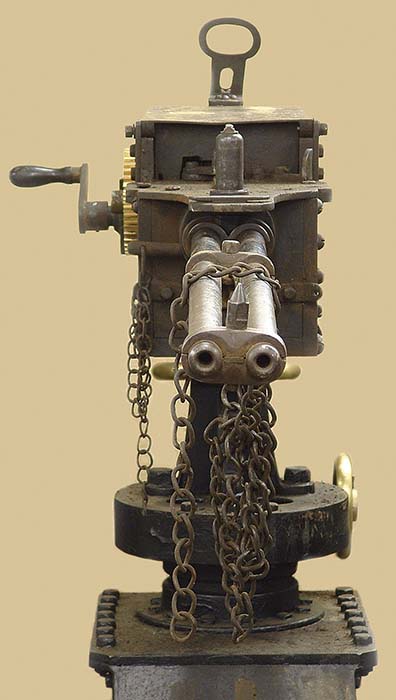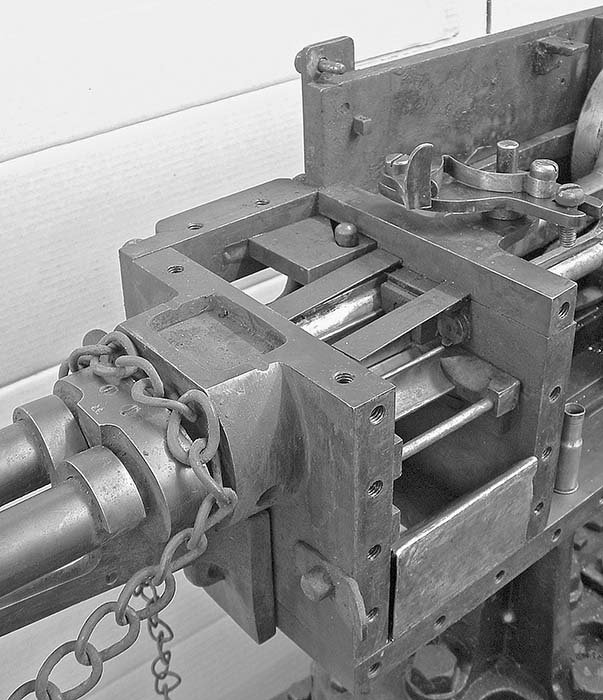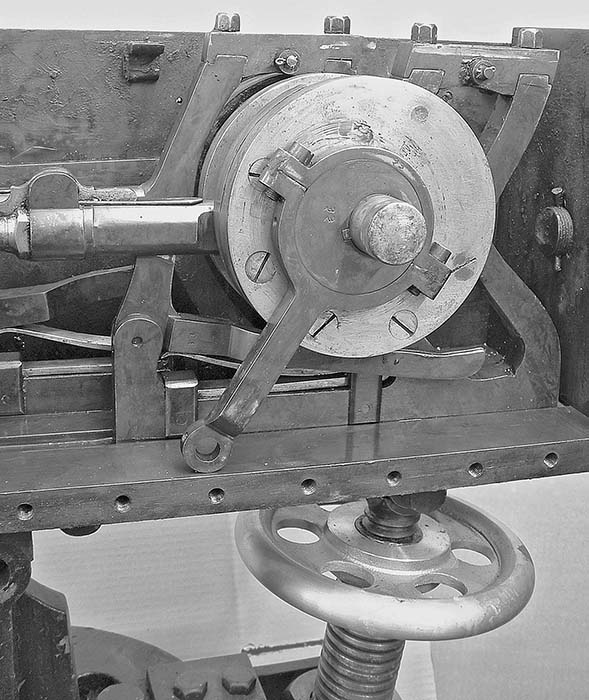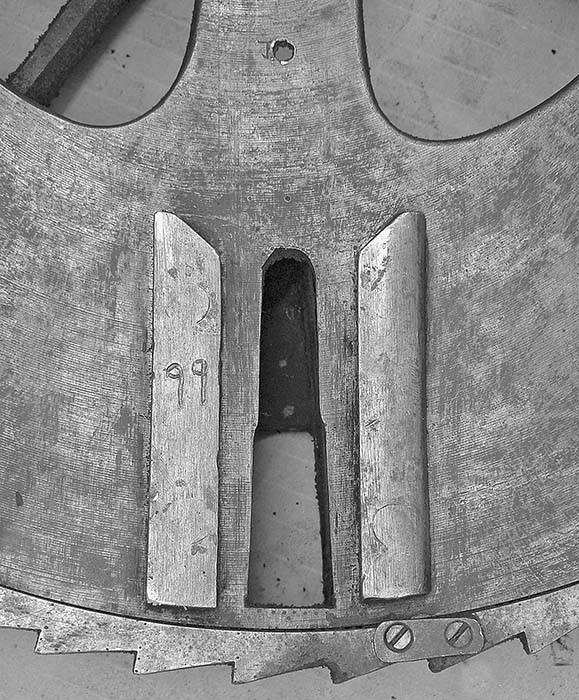The right side of the Bira Gun no. 33, showing the operating handle (geared up so that the drive axle turns more slowly than the handle), and the dedication plate. The pivoting cover allows the feed to be inspected; the gun actually ejects through the bottom of the receiver.
By John Walter
The enthusiasm for multi-shot weapons is almost as old as the gun itself, as even a few multi-barreled matchlocks were made. The ultimate expression of these ideas, at least in medieval times, was the ribaldequin – which consisted of a battery of barrels, usually in a horizontal line, which could be fired by a powder-train in a trough at the rear. The opportunity was also often taken to splay the barrels to increase the field of fire. The ribaldequin had obvious disadvantages. Though potentially devastating if the volley was fired effectively, it was very slow to re-load and easily outflanked by horsemen.
Improvements in large multi-shot weapons awaited improvements in technology predicted by the designs of Englishman James Puckle early in the eighteenth century; which combined a single barrel and a large rotatable disc containing individual chambers for powder and ball. The Puckle Gun fired sequentially, and can be justifiably regarded as the precursor of the machine gun.
The introduction of percussion-ignition allowed development to focus on the self-contained cartridge, and several surprisingly efficient capping breech-loading rifles were introduced. These in turn inspired the development of the pin fire and rim fire cartridges, and thoughts turned once more to rapid-fire weaponry.
A major catalyst in the development of the machine gun was, as always, war – in particular, the American Civil War of 1861-5, where a variety of designs appeared, and the war between France and Prussia in Europe (1870-1) where the de Reffye Mitrailleuse was expected to give the French a great advantage in combat. The truth was more prosaic: the earliest Gatling Guns fired separately capped ammunition and were prone to misfire; the Mitrailleuse was seen more as light artillery than an infantry-support weapon, and its value was lost in this tactical ignorance.
Huge advances were made in the 1870s, when the mechanically operated machine gun was perfected. The Gatling, Gardner and Nordenfelt were the most successful in rifle calibers, whereas the 37mm Hotchkiss probably saw the greatest distribution among the large-caliber designs. Yet the heyday of the mechanically operated machine gun was brief, stretching only from the end of the American Civil War until the 1890s, when the lure of the Maxim became irresistible. Manually-turned cranks had too many weaknesses to resist the advance of the automatic machine gun, and the fascinating Nepalese Bira Gun may have been among the last expressions of its type.

The Nepalese had often asked the British and Indian governments for access to machine guns, but these authorities, fearful (with good reason) that the Nepalese would simply copy them, had always refused the requests. When the British supplied thousands of Martini- Henry rifles in 1894, in response to a request for assistance, they declined to supply many of the other military stores sought by the Nepalese. Deprived of the Gardner and Nordenfelt guns, therefore, the Nepalese decided to make guns of their own.

Design work was undertaken by Gehendra Shamsher Jang Bahadur Rana, who had risen to the rank of general before his death in 1905, aged only 34, and was regarded as the foremost Nepalese military engineer of his day. Gehendra clearly based his work on the Gardner Gun, developed by William Gardner of Toledo, Ohio, and protected by U.S. Patents No. 174130 of February 1876 and No. 216266 of June 1879.
Though strenuously championed by Pratt & Whitney, the Gardner Gun was never able to displace the Gatling in the U.S. Army. However, it was much more popular in Britain. By the end of March 1884, according to the 1883/4 budget, the Royal Navy was to have had 565 Nordenfelts, 350 Gardners and 142 Gatlings. The Gardner proved to be successful in service, being made with one, two, five and six barrels.
The Bira Gun
Named in honor of King Prithvi Bir Bikram Shah, who reigned from 1881 to 1911, the Bira Gun shares the basic operating system of the Gardner even though the magazine and feed systems differ. The most important details of its history were placed on a red-filled castbrass plate on the right side of the body between the feed and the crank handle, including a long dedication to the king (customary with Nepalese artillery) and a date of acceptance into service in the 1890s. It is suspected that only about fifty guns were made immediately prior to the war with Tibet that began in 1897, as no gun has yet been found with a higher number.
The Bira Gun takes the form of a small artillery piece, mounted on a carriage with a trail made of inverted L-shaped wrought-iron girders. The barrels are about 41.3 inches long, placed side-byside about 46 inches from the ground. The entire gun weighs about 900 pounds without the distinctive pan magazine. The gun is mounted on a central pillar, and can be elevated or traversed with the assistance of hand wheels. The carriage wheels, with a diameter of about 36 inches, each have twelve spokes and an iron tire which has been shrunk onto the rims.
An exceptionally sturdy open-topped iron box-body, held together with large slotted-head screws, has a top plate (pivoted at the front) that lifts up and forward to expose the breech – or, more accurately, the inner dust cover over the mechanism. Removing the dust cover reveals two cylindrical breech-bolts, attached to massive iron slides, which are driven by cam plates on the transverse operating handle axle.
Each slide consists of a base block, rising at the rear to a cam path closed by a dovetailed bracket held by hexagon nuts. A massive V-spring on the base provides the power for the striker, which is retracted and released by a rocking L-bar with a tip that passes up into a slot in the underside of the bolt.
The cam plates, one for each barrel, are rigidly attached to discs on the operating handle axle. They control the operating sequence of the gun. An eccentric on the crank axle, on the left side of the body (looking from the rear), drives the magazine-rotating pawl by way of a slider attached to the left body side plate; a similar eccentric on the right drives the feed tray cam plate.
The feed tray, which is moved laterally by a peg acting in the cam plate slot, is a vital component of the mechanism. It consists of two parallel bars, held apart by three spacers. The central spacer is raised to act as a partition between the two rotating spools, each with four troughs that control not only the supply of cartridges but also the ejection process. Two C-shaped leaf springs, with the tips extended, are attached beneath the rear of the feed tray by pegs and small screws. They run towards the front of the tray, where each splays outward.
The magazine is a heavyweight pan, about 16 inches in diameter, comprising an iron base plate, a body containing brass chambers in groups of ten between radial spokes, and a comparatively light sheet-iron top cover. Each of the chambers can hold two .450 cartridges with their noses towards the center. The magazine locates over a spindle projecting from the centre of the feed block cover plate. (There is some circumstantial evidence to suggest that each gun was accompanied by several magazines. This makes sense, as the pans are cumbersome and the loading process is timeconsuming. However, too few of the surviving magazines have been exam ined to allow a proper conclusion to be drawn.)
The operating cycle is relatively simple. If the right-hand bolt is forward, with a spent case under its extractor, then the left-hand bolt is at the limit of its rearward stroke, drawn back behind the feed tray. As the operating handle is turned – oddly, back towards the firer – the parts begin to move. The right-hand bolt is drawn back, extracting the spent case, and the left-hand bolt moves forward against the base of the cartridge that has dropped from the feed way into one of the troughs in the left-hand feed tray spool. As the crank handle rotates farther,the right-hand bolt pulls the spent case out of the chamber and the left-hand bolt pushes a new round home. Nearing the end of the stroke, the right-hand extractor is cammed upward to release the spent case.
At the very end of the stroke, the lefthand cam disc suddenly releases the rocking lever it has been pressing down, and the lever head propels the left-hand striker to fire the cartridge in the lefthand chamber. Continuing to turn the lever repeats the process in reverse, and the right hand-barrel fires to complete one revolution of the crank handle.
The eccentric in the right hand side of the body oscillates the feed tray during the firing process, flicking an extracted case sideways (as the backward-moving bolt clears the end of the sprung spool) and positioning a spool-trough to receive a new round from the feed way. Cartridges are delivered by turning the magazine one-sixtieth of a revolution during each operating cycle, the movement being undertaken by a spring loaded pawl driven by the left-hand eccentric by way of a slide fixed in the left body wall. The magazine rotating pawl protrudes through a slot cut inthe sheet metal shroud slotted verticallyinto the body beneath the front edge of the top cover. The magazine is prevented from over-rotating by a regulating pawl, with an attendant spring, set into the left rear side of the feed cover plate.

Two sets of sights were provided: one for point-blank range, consisting of a groove in the rear of the cascabel plate and a blade on top of the magazine spindle; and another, for longer ranges, in which the blade on the spindle was used in conjunction with another blade mounted above the muzzles. A decorative sheet-brass clinometer, with a hanging pendant, lies on the left rear side of the body. However, as there are neither graduations nor any way of compensating for the angle the gun may make with the ground, its value would have been minimal.

The Bira Gun is exceptionally sturdy for a rifle caliber cartridge. All the parts are massive, contributing greatly to its great weight, and even the retaining screws are large. The quality of the material looks to be better than that used in the Martini-Henry and Gehendra rifles made in Nepal in the same period, and the springs still work after a nearly a hundredyears of inactivity.

The method of attaching the barrels to the front plate of the body is unusual, as they require a sturdy cross-pin (held to the gun by a captive chain) and a cradle beneath the breech to hold them in place. However, as the cartridges chamber directly into the barrels, any play in the construction – though it may affect pointof- strike – would not compromise safety. Another manufacturing quirk may be seen in the construction of the feed cover plate, where the cartridge aperture block is held by a narrow transverse shim (attached to the block by a hidden screw) and then by a broader flat fillet dovetailed on each side into the feed cover plate. This method presumably allowed a selection of shims to be tried until the parts meshed satisfactorily.

Most of the individual parts are numbered, even to the eccentric straps and the feed block C-springs, and the ‘handed’ parts are also identified by the initial Nagari characters of the words ‘left’ or ‘right.’ The Bira Guns were all hand made and adjusted individually during assembly; consequently, the major parts will only occasionally interchange satisfactorily. Even the screws are threaded individually, and should be carefully numbered if the gun is ever dismantled as there is no guarantee that screws selected at random will enter anything other than their original seat!
Several Bira Guns were brought out of Nepal in the mid 1970s, by Interarms, but lacked their feed blocks. The remaining survivors were acquired by Christian Cranmer of International Military Antiques, Inc., and his partners. These are largely complete, and it will not be long before some of them can be fired…
(For background information of the acquisitions in Nepal, see Treasure is where you find it (Tharston Press, 2004) and Guns of the Gurkhas (Tharston Press, 2005).
| This article first appeared in Small Arms Review V11N2 (November 2007) |











